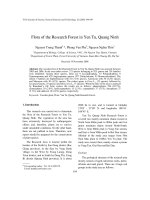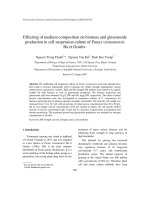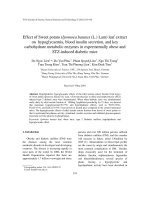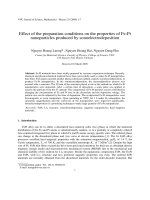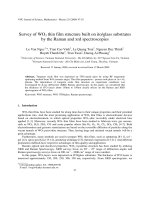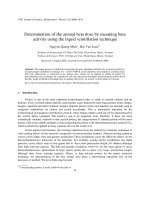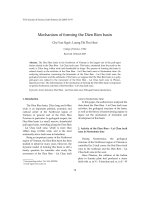Báo cáo " Paleomagnetism of cretaceous continental redbed formations from Indochina and South China, their Cenozoic tectonic implications: a review " pdf
Bạn đang xem bản rút gọn của tài liệu. Xem và tải ngay bản đầy đủ của tài liệu tại đây (352.03 KB, 11 trang )
VNUJournalofScience,EarthSciences23(2007)220‐230
220
Paleomagnetismofcretaceouscontinentalredbed
formationsfromIndochinaandSouthChina,
theirCenozoictectonicimplications:areview
CungThuongChi*
InstituteofGeologicalSciences,VietnameseAcademyofScienceandTechnology
Received28August2007;receivedinrevisedform25October2007
Abstract. Available paleomagnetic data of Cretaceous redbed formations from Indochina and
SouthChinablocksarecompiledandtheirtectonicsignificanceisreviewedinacommonreference
frameoftheEurasiancoevalpaleopoles.Theimportantfactorsthatplayavitalrole
indetermining
thetectonicsignificanceofapaleomagn etic resulthavebeentakenintoconsiderationanddiscussed.
ReviewoftheCretaceouspaleomagneticdatafromtheSouthChinablockfurtherconfirmsthe
conclusion of the previous researchers that the present geographic position of the South China
block has been relativelystable with
respect to Eurasia since Cretaceous time and shows thatthe
paleomagnetically detected motion of a coherent lithospheric block must be based on the
representativedataobtainedfromdifferentplacesacrosstheblock;sothelocaltectonicmovements
canbedistinguished.
Cretaceous paleomagnetic data from the Indochina‐Shan Thai block reveal complex
intra‐
platedeformationsthathave beenoccurreddueto theIndia‐Eurasiacollision.Paleomagnetically
detected motions from the block‐margin areas are mainly reflecting the displacement of upper
crustal blocks due to folding and faulting processes, thus a rigid lithospheric block rotation and
translationcannotbe assumed.Thepaleomagneticresultsfromtheareaslocatednexttothe south
of the Red River fault suggest that the fault does not demarcate non‐rotated and significantly
rotatedregions.Accordingly,giventhedifficultyinseparatingtruelithosphericplatemotionsfrom
thoseof superficialcrustal blocks,weadvocate extremecaution in interpretingthe paleomagnetic
record
inregionssuchasIndochinawhereblockinteractionandstrongdeformationareknownto
haveoccurred.
Keywords:Paleomagnetism;Cretaceous;Indochina;SouthChina;Tectonics.
1.Introduction
*
Thetectonicsof SoutheastAsian regionhas
attractedtheattentionofsuccessivegenerations
_______
*Tel.:84‐4‐913222102
E‐mail:
ofgeologistsintheworld.Manyactivetectonic‐
geodynamic evolutions have been occurring at
thisregion,suchas:thesubductionoftheIndo‐
Australian pla te under the Eurasia plate along
the Indonesia arc; the India‐Eurasia collision
anddifferentintra‐platedeformationprocesses.
Therefore, it can consider the Southeast Asian
CungThuongChi/VNUJournalofScience,EarthSciences23(2007)220‐230
221
region as a natural laboratory for active
tectonics‐geodynamics, facilitating geologists
to use the region’s modern tectonics as an
analog for processes interpreted in the
geological record. During the last two decades
of the 20
th
Century, the model of extrusion
tectonics [21] has emerged as the predominant
modelforthetectonicsofSoutheastAsia.
During recent years, paleomagnetic studies
on geological formations from Southeast Asian
region have been increased both in quantity
and quality, contributing to elucidate the
tectono‐geodynamic context, the paleo‐
geographic reconstruction
of lithospheric
blocks, microcontinents that were welded
together to form the actual Eurasia continent
(Fig.1).However,itisnotquitestraightforward
to interpret the paleomagnetic results of an
active tectonic region such as Southeast Asia,
becausetheprimarypaleomagneticvectormay
bemodifiedbysubsequenttectoniceffects,such
as stress
and temperature changes, or fluid
migration, etc. Paleomagnetically detected
movementsmaysometimesreflectlocalrotations
relatedtoshearzones [13, 17],theycanalsobe
causedbylocal deformationinthrustsheets,or
in arc related defo rm atio n [14]. The refore,
coherent movements of plates, or microplates
cannotbe assumed. An important
aspectof the
interpretation of the paleomagnetic results of
Southea stAsianregionisthereforetounderstand
the origin of the paleomagnetically observed
movements.Whatistheextentintimeandspace
of particular movement? Are there criteria we
can establish to distinguish plate movements
fromuppercrustalblockmovements?
Themain
goalofthispaperistocompilethe
available paleomagnetic data of the Cretaceous
continental redbe d formations from Indochina
andSouthChinaregionscarriedoutbydifferent
researchers and to discuss their tectonic
significance, especially the paleomagnetically
detected movementsof these formations caused
by the India‐Eurasia collision during the
Cenozoic. The accuracy and reliability of the
paleomagnetic data are not problem to be
discussed but the tectonic interpretation of
thesedata,thereforethetypicalfactorssuchas:
the origin of rock’s magnetization (primary or
secondary?), the age of the rock formation, the
effects of the tectonic deformation play a vital
roleindeterminingtheirtectonicsignificance.
The relative rotation and translation of a
tectonic blockdetectedfromthe paleomagnetic
directions of geological formations located
withinthatblockaredeterminedbycomparing
theobserveddirectionswiththecoevalexpected
directionsofareferenceblockorcontinentthat
itsApparentPolarWander
Path(APWP)iswell
determined for each geological period. Besse
andCourtillot[1]hasderivedanAPWPforthe
Eurasiacontinentfrom200Matopresentwitha
high precision, therefore the paleomagnetic
directions of the Indochina and South China
blockspresentedinthispaperwillbecompared
with the expected
directions calculated from
thisAPWPforcertaingeologicalperiod(Table1)
fordiscussingtheirtectonicsignificance.
2. Cretaceous paleomagnetic results of the
SouthChinaBlock
According to Hsu et al. [11], the South
Chinablockconsistsoftwomicro‐continent sthat
aretheYangtzeCratonsituatedtothenorthwest
and
theHoaNamblocktothesoutheast.These
two micro‐continents were welded together
during the subduction process of the paleo‐
Pacific plate under the Eurasia plate in late
Mesozoictime,alongtheJiangnansuture zone,
which consists of Mi ddle to Upper Proterozoic
low‐grade metamorphic rocks. Xu et al. [22],
however,suggestthattheentireeasternpartof
the Chinese landmass was dominated by a
Mesozoic sinistral shear system. Xu et al’s view
has been supported by the isotopic and
paleomagneticstudyontheJurassic‐Cretaceous
intrusive rocks that are widely expos ed to th e
southeasternpartoftheSouthChina
block[10].
CungThuongChi/VNUJournalofScience,EarthSciences23(2007)220‐230
222
Fig.1.TectonicsketchoftheSoutheastAsiaregion
andtheobserveddeclinationsofCretaceousgeologicalformations.
Table1.ApparentPolarWanderPathforEurasiaderivedbyBesseandCourtillot(1991).
Age
(Ma)
λ
(
0
N)
φ
(
0
E)
A
95 Age
(Ma)
λ
(
0
N)
φ
(
0
E)
A
95 Note
10 84.1 149.1 2.3 110 73.3 206.5 5.1
20 82.3 147.6 3.2 120 74.8 210.9 4.1
30 81.0 132.8 2.7 130 75.2 205.8 5.0
40 80.2 145.4 3.8 140 71.6 173.0 10.4
50 77.9 149.0 4.3 150 70.0 157.8 6.7
60 78.5 178.7 3.9 160 68.8 154.9 6.0
70 77.2 192.4 4.1 170 63.3 120.7 3.0
80 76.2 198.9
3.4 180 64.2 116.7 2.7
90 76.7 200.1 3.5 190 66.7 109.0 3.9
100 76.7 197.1 5.4 200 67.3 111.6 6.7
MeanEocenepoles 79.8 143.1 3.330Ma‐50Mapoles
MeanK2poles 77.2 193.9 2.060Ma‐100Mapoles
MeanK
1poles74.3 198.1 6.0 110Ma‐140Mapoles
MeanKpoles 75.9 196.0 2.560Ma‐140Mapoles
MeanJ3‐Kpoles 75.4 186.6 3.660Ma‐160Mapoles
MeanJ
3‐K1poles73.7 181.8 6.7 110Ma‐160Mapoles
CungThuongChi/VNUJournalofScience,EarthSciences23(2007)220‐230
223
Mostofthegeologistsagreethat,uptoLate
Jurassic, the South China block has been
alreadyaccretedtotheNorthChinablockalong
the Qinling suture belt, forming the stable
Eurasia continent. During the last decades of
the 20
th
Century, a series of paleomagnetic
studies have been carried out on the Mesozoic
and Cenozoic rock formations in China, which
allow to construct the apparent polar wander
paths (APWP) of the South China and North
China blocks since Late Permian time to
present. Comparison of these APWPs with the
APWP
of the Eurasia continent indicates that:
since the Cretaceous, the South China and
North China blockshave been relatively stable
to the Eurasia plate [7]. The India‐Eurasia
collision during the Cenozoic has not
significantly affected to the South China and
NorthChinablocks[4,7].
Paleomagnetic data of the Cretaceous
continental redbed formations from the South
China block are listed in Table 2. The relative
rotation and latitudinal translation of studied
localities are illustrated in Fig. 2 and Fig. 3
respectively. Among 23 pa leomagnetic studied
localities, there are only 6 localities have been
subjected to both relative rotation and
latitudinal
translation, mainly from the Late
Cretaceous‐Eocence continental redbed
formations; from other 6 sites only relative
rotation has been found and two other sites
showonlythelatitudinaltranslation.
WhencomparingtheEarlyCretaceous,Late
Cretaceous and Cretaceousmeanpaleopoles of
the South China block to the corresponding
paleopoles of the
Eurasia, however, they show
that there is neither significant rotation nor
latitudinal translationof theSouthChinablock
relative to the Eurasia continent. This further
confirms the conclusion of other researchers
mentioned above [4, 7]. The relative rotation
and translation found from some study
localitiesonlyreflectalocaltectonic
movement
of the upper crustal blocks but not the motion
of the whole lithospheric block. That is why,
bigger degrees of rotation have been found
from younger rock formations (Eocene, Late
Cretaceous) while the older, underlying rock
formations have been less dislocated or
unaffected(EarlyCretaceous).
-50
-40
-30
-20
-10
0
10
20
30
40
50
60
18 19 20 21 22 23 24 25 26 27 28 29 30 31 32 33
Locality Latitude (
o
N)
Rotation Degree (o)
Counterclockwise Clockwise
Mean K1 poles
Mean K2 poles
Mean K poles
Fig.2.RelativerotationoftheSouthChinaterraneswithrespecttoEurasia.
CungThuongChi/VNUJournalofScience,EarthSciences23(2007)220‐230
224
Table2.Cretaceous‐EocenepaleomagneticresultsoftheSouthChinablock.
Location ObservedVGPExpectedVGP Rotation Translation
N
λ (
0
N) φ (
0
E)
Age
λ (
0
N) φ (
0
E)
A
95
λ (
0
N) φ (
0
E)
R±∆R λ±∆λ
Sign. Ref.
SouthChinablock
1 25.7 101.3 E 72.3 218.4 4.5 79.8 143.1 8.3±6.1 16.3±5.6 Y/Y [25]
2 26.1 101.7 E 70.1 224.6 4.9 79.8 143.1 9.1±6.5 19.2±5.9 Y/Y [25]
3 25.7 102.1 K2‐E 61.8 192.2 10.5 77.2 193.9 16.6±11.6 2.2±10.7 Y/N [25]
4 25.9 101.8 K2‐E 65.6 203.0 2.6 77.2 193.9 11.3±3.5
5.7±3.2 Y/Y [25]
5 25.0 116.4 K2 67.9 186.2 9.2 77.2 193.9 10.1±10.9‐3.5±9.4 N/N [7]
6 26.0 117.3 K2 65.1 207.2 5.0 77.2 193.9 13.1±6.0 4.8±5.4 Y/N [10]
7 23.1 113.3 K2 56.2 211.5 3.9 77.2 193.9 20.8±4.6 9.9±4.4 Y/Y [10]
8 24.4 112.3 K2 66.0 221.5 3.4 77.2
193.9 9.3±4.1 10.8±4.0 Y/Y [7]
9 30.0 102.9 K2 72.8 241.1 6.6 77.2 193.9‐2.8±7.3 12.3±6.9 N/Y [7]
10 32.0 119.0 K2 76.3 172.6 10.3 77.2 193.9‐0.7±13.6‐4.8±10.5 N/N [7]
11 30.8 118.2 K2 83.8 200.3 14.6 77.2 193.9‐7.7±17.4 1.6±14.7 N/N [24]
12 25.0 101.5 K 49.2 178.0 11.4
75.9 196.0 30.3±13.2‐4.2±11.6 Y/N [7]
13 30.1 103.0 K 76.3 274.5 11.1 75.9 196.0‐14.0±11.9 11.9±11.4 Y/Y [7]
14 22.2 114.2 J3‐K 78.2 171.9 10.6 75.4 186.6‐4.2±12.6‐2.2±11.1 N/N [2]
15 30.0 102.9 K1 74.5 229.0 4.0 74.3 198.1‐4.4±8.0 7.2±7.3 Y/N [7]
16 18.9 109.4 K1
83.2 143.0 9.8 74.3 198.1‐12.5±12.5‐6.0±11.5 N/N [24]
17 22.7 108.7 K1 86.5 26.4 10.0 74.3 198.1‐20.8±12.7‐1.1±11.6 Y/N [10]
18 26.0 117.3 K1 66.9 221.4 5.4 74.3 198.1 6.2±8.9 8.9±8.1 N/Y [7]
19 26.5 102.4 K1 81.5 220.9 7.1 74.3 198.1‐9.0±10.2 1.7±9.3 N/N [12]
20 26.8 102.5
K1 69.0 204.6 4.3 74.3 198.1 4.8±8.0 3.5±7.4 N/N [12]
21 27.9 102.3 K1 77.4 196.2 14.5 74.3 198.1‐3.2±17.5‐1.1±15.8 N/N [7]
22 27.9 102.3 K1 85.2 241.7 3.5 74.3 198.1‐13.9±7.6 1.0±7.0 Y/N [25]
23 29.7 120.3 K1 77.1 227.6 5.5 74.3 198.1‐4.5±9.4 6.6±8.1 N/N [7]
Mean
K1poles(13‐23): 80.0 216.1 5.4 74.3 198.1‐7.1±8.82.2±8.1 N/N
MeanK2poles(3‐11): 69.2 203.6 6.6 77.2 193.98.4±7.53.8±6.9 Y/N
MeanKpoles(3‐23): 74.2 204.9 5.0 75.9 196.01.4±6.12.6±5.6 N/N
Note:Sign.=Significance(Y:Yes,N:No),Ref.=Reference,K1=EarlyCretaceous,K2=LateCretaceous,K=
Cretaceous, J3‐K = Late Jurassic‐Cretaceous, K2‐E = Late Cretaceous‐Eocene, E= Eocene. Rotation and
latitudinal translation were calculated at each study locality following Butler (1992); negative
(positive) sign
indicatesCCW(CW)rotationandsouthward(northward)t ranslation,respectively.ExpectedVGPsarecalculated
fromEurasianpoles(Table1)derivedbyBesseandCourtillot(1991).
We can also see that the tectonic
interpretation of a whole lithospheric block
basedonthepaleomagneticresultsfromseveral
study localities, especially from active tectonic
areas,canbeinaccurate.Itisimportantthatthe
paleomagnetically detected motion of a
lithospheric block must be based on the
representative data obtained from
different
places within the block; so the local tectonic
movementscanbedistinguished.
CungThuongChi/VNUJournalofScience,EarthSciences23(2007)220‐230
225
-25
-20
-15
-10
-5
0
5
10
15
20
25
30
96 98 100 102 104 106 108 110 112 114 116 118 120 122
Locality Longitude (
o
E)
Latitudinal Translation (o)
Southward Northward
Mean K1 poles
Mean K poles
Mean K2 poles
(Eocene)
Fig.3.LatitudinaltranslationoftheSouthChinaterraneswithrespecttoEurasia.
3. Cretaceous paleomagnetic results of the
Indochina‐ShanThaiBlock
Oneoftheterminologiesthathasbeenoften
referred in the Cenozoic tectonic models of
SoutheastAsiaregion is theʺSundalandʺplate.
TheSundalandplateisborderedtothenorthby
the Red River fault, to the west by the Sagaing
faultinMyanmar, to theeast bythePhilippine
subduction zone, and to the south by the
Indonesia subduction zone. This plate consists
of the Shan‐Thai and Indochina blocks, South
China Sea, Borneo, Malaya‐Indonesia Islands.
Duringthedecade90softhe20
th
Century,there
havebeen somereviewsofpaleomagneticdata
from Southeast Asia [8, 16] for discussing the
Cenozoic tectonic evolution of this region. A
most common aspect from these studies is:
regardless the paleomagnetic data have been
compiledatdifferent times, theyalwaysreflect
the tectonic complexity of the Southeast
Asian
region. Contradicting rotations with various
angles have been observed from the same
terrane or from different terranes; from
clockwiserotationofthepaleomagneticvectors
onthecontinentalparttothecounterclockwise
rotation of the paleomagnetic vectors on the
peninsula and islands located to the
southeasternpartoftheregion(Fig.
1).
In this paper, the author will present and
discussonlytheCretaceouspaleomagneticdata
of the Shan‐Thai and Indochina blocks that
havebeencarriedoutduringthelast20yearsin
order to highlight the nature of intraplate
deformation due to the impact of the India‐
Eurasiacollision.
According to the Extrusion model, the
Indochina block has been rotated about 40
0
clockwise andsouthwardextruded about 800‐
1000kmalongthesinistralRedRiverfaultand
Me Kong River fault in order to accommodate
the convergence of the India‐Eurasia collision.
One of the paleomagnetic study carried on the
Late Jurassic‐Early Cretaceous sedimentary
formation from the Khorat Plateau (16.5
0
N,
103.0
0
E), Thailand [23] has been often cited as
an evidence supporting this model. Selecting
fiveLateJurassic‐EarlyCretaceous paleopoles
CungThuongChi/VNUJournalofScience,EarthSciences23(2007)220‐230
226
from the South China block, the authors have
determined that the Indochina block has been
rotated 14.2±7.1
0
clockwise and southward
extruded 11.5±6.7
0
relative to the South China
block since the Cretaceous time. In this study,
however, when we use the J
3‐K1 paleopole of
theEurasiacontinentasareference,theKhorat
Plateauhasbeenrotatedonly10.2±7.3
0
clockwise
andisinsignificantlysouthwardextruded3.4±
6.9
0
relative to the Eurasia (Table 3, Fi g. 4 and
5). So, we can see here the importance of
selection of the reference paleopole for the
tectonicinterpretationofapaleomagneticresult
from a particular area. In order to select a
representative paleopole of a tectonicblock for
a certain geological
period, there are two
critical factors that decide the accuracy,
reliabilityof thereferencepaleopole, whichare
theageoftherockformation,andthereference
paleopole must be computed from the coeval
paleopolesobservedfromdifferentareaswithin
the block. Certainly, those anomalous
paleopoles, which are clearly affected by the
localtectonicactivitiesshouldbeexcluded.
InVietnam,thepaleomagneticstudyresults
of the Cretaceous extrusive, intrusive, and
sedimentary rock formations from southern
and northwestern Vietnam [5, 6] show that: 1)
Since the Cretaceous, the southern part of
Vietnam has not been significantly rotated but
has been translated6.6±6.4
0
southward relative
to the Eurasia continent [5];2)thenorthwestern
Vietnam (Tu Le depression) has not been
significantly rotated nor latitudinal translated
relative to the Eurasia continent since the
Cretaceous[6].
TheCretaceouspaleomagneticresultsofthe
northwestern Vietnam are similar to the
paleomagnetic data of the Late Cretaceous
redbed
formation from the Xiaguan locality‐
Yunnan, China, situated next to the Red River
fault [12]. Recently, Takemoto et al. [20] has
carried out a paleomagnetic study on the Yen
Chau redbed formation(SongDa Terrane) and
alsoobtainconsistentresultswiththeresultsof
the Tu Le Depression (Table 3, Fig.
4 and 5).
Thus,itcanconcludethattheRedRiverfaultis
not a demarcation between the South China
block and the Indochina block [6, 12, 20], and
there are insignificant displacements of the
Indochina terranes located just to the south of
the Red River fault, a basic tenet
of the
extrusiontectonicmodel.
In recent years, many paleomagnetic
studies have been carried out on the Eocene‐
Creataceousredbedformationsfrom theSimao
terraneinYunnan,China[3,12,18,24].Interms
of geographical position, this area belongs to
the Yunnan Province of China, but in terms of
tectonic
aspect, this area situates within the
ShanThaiblockneartotheEastern Syntaxisof
the India‐Eurasia collision belt (Fig. 1); where
strong folding and faulting deformations
occurredduetotheimpactoftheIndia‐Eurasia
collision. Therefore, different paleomagnetic
results have been observed on the Eocene‐
Cretaceous redbed
outcrops from different
localities in this area, reflecting the local
tectonic displacements. Clockwise rotations
with different angles up to 100
0
and
insignificant latitudinal translations relative to
theEurasia(Table3,Fig.4and5)clearlyreflect
the nature of local tectonic movement of the
upper crustal blocks during folding processes
[14]. Furthermore, at the several localities such
as Lanping, Mengla bigger clockwise rotations
have been observed on the Eocence overlying
redbed layers and smaller clockwise rotations
oftheLateCretaceousunderlyingredbedlayers
(Fig. 4); as well as contradicting l atitudinal
translationsoftheover‐andunderlyingredbed
layers(Fig.5)clearlyindicatethecomplexityof
local tectonic displacements. Another possible
explanationmightbethereliabilityoftherock’s
age; as mentioned
above, it is difficult to
determine precisely the age of continental
redbeds because the fossils are often rarely
found in the rock. Therefore, the detailed age
CungThuongChi/VNUJournalofScience,EarthSciences23(2007)220‐230
227
classification of the redbed formations is
difficult,inmanycasesitisbasedmostlyonthe
stratigraphic correlation, and this can lead to a
wrong or inaccurate tectonic interpretation of
paleomagnetic data and sometimes making
controversial conclusions, especially wherehas
beenstronglydeformedliketheSimaoterrane.
Anotherpaleomagneticstudy
onLateJur ass ic
‐ Cretaceous cont in ental redbeds situated at the
western margin of the Shan Thai block [16],
neartotheSagaingright‐lateralstrike‐slipfault
(Fig. 1), shows that the study area has been
rotated 29.1±5.2
0
clockwise and northward
translated 7.8±4.0
0
(Table 3, Fig. 4 and 5). The
observedmotionofthisareashouldalsoreflect
the dextral displacement of the Sagaing fault,
because itis a greatlongitudinaltrendingfault
with a length of more than 1000 km that has
beenformedand beingpresentlyactiveduring
the India‐Eurasia
collision process. Therefore,
geologicalformations, which situate withinthe
faultzonecertainlywillbeaffectedbythefault
activity.
Thatiswhy,thepaleomagneticallydetected
motions of the rock formations, which located
within active tectonic areas (fault zone,
extension zone, collision belt, interactive area
between blocks or plates, etc.), are likely
representativeforthestudyareaitself.Itwould
be so subjective and ignorant if one uses the
observed paleomagnetically detected rotation
andtranslationofsuchareatomakeconclusion
that these data reflect the coherent motion of
thewholelithosphericblock.
Table3.Cretaceous‐EocenePaleomagneticresultsoftheIndochinablock.
ObservedVGPExpectedVGP Rotation Translation
Locality
Lat
(
0
N)
Long
(
0
E)
Age
λ (
0
N) φ (
0
E)
A
95
λ (
0
N) φ (
0
E)
R±∆R λ±∆λ
Sign. Ref.
Indochinablock:
SongDaterr ane 21.7 103.9 K2 82.9 220.7 6.9 77.2 193.9‐7.0±7.6 2.7±7.1 N/N
[20]
TuLeBasin 21.7 104.2 J3‐K 83.9 233.1 11.9 75.4 186.6‐10.7±13.1 5.1±12.4 N/N [6]
Vinhlocality 18.5 105.4 K‐‐‐76.7 197.1 25.9±9.0‐13.4±10.7 Y/Y [15]
SouthVietnam 11.7 108.2 K 74.2 171.1 5.9 75.9 196.0 0.4±6.7‐6.6±6.4
N/Y [5]
KhoratPlateau 16.5 103.0 J3‐K1 63.8 175.6 1.7 73.7 181.8 10.2±7.3‐3.4±6.9 Y/N [23]
ShanThaiblock:
SimaoTerrane:
Lanping 26.5 99.3 E 14.5 169.7 10.9 79.8 143.1 76.5±12.6 9.9±11.4 Y/N [19]
Mengla 23.5 100.7 E 13.2 172.2 5.4 79.8 143.1 76.7±6.9 8.8±6.4 Y/Y [3]
Yunlong 25.8 99.4 K2 54.6 171.3 4.4 77.2 193.9 26.0±5.6‐7.0±4.9 Y/Y [18]
Xiaguan 25.6 100.2 K2 83.6 152.7 10.0 77.2 193.9‐8.2±11.7‐5 .3±10.2 N/N [12]
Jinggu 23.4 100.9 K2 18.9 170.0 8.9 77.2 193.9 65.7±10.1 ‐3.9±9.1 Y/N [12]
Mengla 21.6 100.4 K2 33.7 179.3 8.2 77.2 193.9 47.2±9.0‐0.4±8.5 Y/N [12]
Lanping 25.8 99.4 K2 69.7 167.6 6.9 77.2 193.9 8.2±8.4‐7.5±7.1 N/Y [24]
Yongping 25.5 99.5 K1 50.9 167.3 20.6 74.3 198.1 27.5±25.7 ‐11.1±21.5 Y/N [9]
Jinggu 23.5 100.7 K1‐13.9 161.3 4.3 74.3 198.1 99.2±7.9 0.6±7.4 Y/N [3]
ShanPlateau 20.4 96.3 J3‐K 46.4 190.6 3.5 75.4 186.6 29.1±5.2 7.8±4.0 Y/Y [16]
Note:Ref.=Reference,Sign.=Significance(Y=Yes,N=No).K1=EarlyCretaceous,K2=LateCretaceous,K
= Cretaceous, J3‐K = Late Jurassic‐Cretaceous, J3‐K1 = Late Jurassic‐ Early Cretaceous, E= Eocene. Rotation and
latitudinal translation were calculated at each study locality following Butler (1992); negative (positive) sign
indicatesCCW(CW)rotationandsouthward(northward)translation,respectively.Expectedpolesarecalculated
(Table1)fromEurasianpolesderivedbyBesseandCourtillot(1991).
CungThuongChi/VNUJournalofScience,EarthSciences23(2007)220‐230
228
-40
-30
-20
-10
0
10
20
30
40
50
60
70
80
90
100
110
120
10 11 12 13 14 15 16 17 18 19 20 21 22 23 24 25 26 27 28
Locality Latitude (
o
N)
Rotation Degree (o)
Counterclockwise
Clockwise
South Vietnam (K)
Khorat Plateau (J3-K1)
Shan Plateau (J3-K)
North Vietnam (J3-K)
Simao Terrane
(E)
Mengla
Jinggu(K1)
Jinggu(K2)
Lanping(E)
Yunlong(K2)Yongping(K1)
Lanping(K2)
X
iaguan(K2)
(K2)
Fig.4.RelativerotationoftheIndochina‐ShanThaiterraneswithrespecttoEurasia.
-35
-30
-25
-20
-15
-10
-5
0
5
10
15
20
25
95 96 97 98 99 100 101 102 103 104 105 106 107 108 109
Locality Longitude (
o
E)
Latitudinal Translation (o)
Southward Northward
Khorat Plateau
North Vietnam
South Vietnam
Shan Plateau
Simao Terrane
Lanping (E)
Mengla
Yongping (K1)
Lanping (K2)
(K2)
Jinggu
(K1)
(K2)
(E)
Fig.5.RelativetranslationoftheIndochina‐ShanThaiterraneswithrespecttoEurasia.
4.Conclusions
The compilation and review of Cretaceous
paleomagnetic data of the South China and
Indochinaregionsleadustoconcludethat:
‐ The present geographical position of the
South China block has been relatively stable
with respect to the Eurasia continent at least
since the Cretaceous. The rotations and
latitudinal
translations, which have been
recorded from some study localities reflect the
localtectonicdisplacementofthe uppercrustal
blocksdue to activetectonicactivities occurred
duringtheCenozoic.
‐ The India‐Eurasia collision process has
strongly deformed the Indochina‐Shan Thai
block, especially the areas located near to the
collision belt.
During the Cenozoic, Indochina
CungThuongChi/VNUJournalofScience,EarthSciences23(2007)220‐230
229
and parts of Sundaland underwent complex
internal deformation and did not behave as a
coherent block as suggested by the extrusion
model.
‐ The Red River fault does not demarcate
theSouthChinablockandtheIndochinablock;
theterranesthatarelocatedjusttothesouthof
this fault have
not been rotated nor translated
significantly relative to the Eurasia continent
since the Cretaceous time. Thus, the tectonic
boundary of the South China and Indochina
blocks in the extrusion model, if ever exists,
mustbelocatedsomewherefurthertothesouth
oftheRedRiverfault.
‐ The southward displacement of
the
southernpartof Vietnamisin accordancewith
the extrusion model, however, no clockwise
rotation has been observed from this area as
wellastheapparentcounterclockwiserotations
have been recorded from Borneo and Malaya
peninsula located further to the south [8]
indicating that the complex tectonic evol ution
of
the Southeast Asian region can not be
completely explained by any simple tectonic
model.
‐ The Cretaceous‐Eocene paleomagnetic
results from the Simao terrane (Shan Thai
block) mainly reflect the displacements of the
upper crustal blocks during the folding and
faulting process caused by the India‐Eurasia
collision.
Thehistoryof
theEarthcrustevolutionhas
beenacomplexprocess,therearemanyproblems
relatingtothetectonic‐geodynamicmechanism
that have been not elucidated yet; what is the
role of the Manti flow under the continental
crust relating to the plate interaction? Whether
the collision, movement processes among
continents, microcontinents associated
with
macma‐orogenesis activities and intra‐plate
deformationhavebeentakenplaceasaresultof
the active plate motion or they are the
consequences of the Manti flow beneath? With
the effort of the interdisciplinary studies of
various geologist generations, these problems
willbecertainlyclarifiedinfuture.
References
[1] J.BesseandV.Courtillot,Revisedandsynthetic
apparent polar wander paths of the African,
Eurasian,NorthAmericaandIndianPlates,and
true polar wander since 200 Ma, Journal of
GeophysicalResearchB96(1991)4029.
[2] L.S. Chan, Paleomagnetism of late Mesozoic
granitic intrusions in Hong Kong: Implications
for Upper
Cretaceous reference pole of South
China, Journal of Geophysical Research B96 (1991)
327.
[3] H.Chen,J.Dobson,F.Heller,J.Hao,Paleomagnetic
evidence for clockwise rotation of the Simao
region since the Cretaceous: a consequence of
India‐Asia collision, Earth and Planetary Science
Letters134(1995)203.
[4] Y.
Chen, V. Courtillot, J.P. Cogne, J. Besse, Z.
Yang,andR.J. Enkin,Theconfigurationof Asia
prior to the collision of India: Cretaceous
paleomagneticconstraints,Journalof Geophysical
ResearchB98(1993)21927.
[5] Cung Thuong Chi and Steven L. Dorobek,
Cretaceous palaeomagnetism of Indochina and
surrounding regions: Cenozoic tectonic
implications.In:
Aspects of the TectonicEvolution
ofChinaeditedbyMalpasJ.,FletcherC.J.N.,AliJ.R.
and Aitchison J.C., Geological Society, London,
SpecialPublication226(2004)273.
[6] CungThuongChi,NguyenTrongYem,Nguyen
Quoc Cuong, Paleomagnetic results of Late
Jurassic‐Cretaceousextrusiveandintrusiverocks
fromnorthwesternregionof
Vietnam,Journalof
GeologyNo1‐2/256A(2000)1(inVietnamese).
[7] R.J. Enkin, Z. Yang, Y. Chen, and V. Courtillot,
Paleomagnetic constraints on the geodynamic
history of the major blocks of China from the
Permian to the present, Journal of Geophysical
ResearchB97(1992)13953.
[8] M. Fuller, R. Haston,
J. Lin, B. Richter, E.
Schmidtke, J. Almasco, Tertiary paleomagnetism
of regions around the South China Sea, Journal
ofSoutheastAsianEarthSciences6(1991)161.
[9] S. Funahara, N. Nishiwaki, F. Murata, Y.‐I.
Otofuji, and Y.Z. Wang, Clockwise rotation of
CungThuongChi/VNUJournalofScience,EarthSciences23(2007)220‐230
230
theRed Riverfaultinferredfrompaleomagnetic
study of Cretaceous rocks in the Shan‐Thai‐
Malay block of western Yunnan, China, Earth
andPlanetaryScienceLetters117(1993)29.
[10] S.A. Gilder,J. Gill,R.S. Coe,X.Zhao,Z. Liu,G.
Wang, K. Yuan, W. Liu, G. Kuang, and H. Wu,
Isotopic and paleomagnetic constraints on the
Mesozoic tectonic evolution of South China,
Journal of Geophysical Research No101/B7 (1996)
16137.
[11] K.J. Hsu, S. Shuh, J. Li, H. Chen, H. Pen, and
A.M.C.Sengor,Mesozoicoverthrusttectonicsin
southChina,Geology16(1988)418.
[12] K. Huang and N.D. Opdyke, Paleomagnetic
results from Cretaceous and Jurassic rocks of
southandsouthwestYunnan:evidenceforlarge
clockwise rotation in the Indochina and Shan‐
Thai‐Malay terranes, Earth andPlanetary Science
Letters117(1993)507.
[13] J. Jackson, and P. Molnar, Active faulting and
block rotation in the western Transverse
Ranges, California, Journal of
Geophysical
Research95/B13(1990)22073.
[14] W.D. MacDonald, Net tectonic rotation,
apparenttectonicrotation,andthestructuraltilt
correction in paleomagnetic studies, Journal of
GeophysicalResearchB85(1980)3659.
[15] Nguyen Thi Kim Thoa, Luu Thi Phuong Lan,
Paleomagnetic study of Jurassic‐Cretaceous
sedimentaryrocksfrombothsidesofRed
River
Fault zone in Vietnam and tectonic
interpretation, Journal of Sciences of the Earth 22
(2000)266.
[16] B. Richter and M. Fuller, Palaeomagnetism of
the Sibumasu and Indochina blocks:
Implications for the extrusion tectonic model.
In: Tectonic Evolution of Southeast Asia edited by
Hall R. and Blundell D., Geological Society
Special
Publication106(1996)203.
[17] H. Ron, R. Freund, Z. Garfunkel, and A. Nur,
Block rotation by strike‐slip faulting. Structural
andpaleomagneticevidence,JournalofGeophysical
Research89(1984)6256.
[18] K. Sato, Y. Liu, Z. Zhu, Z. Yang, Y.‐I. Otofuji,
Paleomagnetic study of middle Cretaceous
rocks
from Yunlong, western Yunnan, China:
evidence of southward displacement of
Indochina,EarthandPlanetaryScienceLetters165
(1999)1.
[19] K. Sato, Y. Liu, Z. Zhu, Z. Yang, Y.‐I. Otofuji,
Tertiary paleomagneticdatafrom northwestern
Yunnan, China: further evidence for large
clockwiserotationoftheIndochinablockandits
tectonic
implication, Earth and Planetary Science
Letters185(2001)185.
[20] K. Takemoto, N. Halim, Y.‐I. Otofuji, Tran Van
Tri, Le Van De, S. Hada, New paleomagnetic
constraints on the extrusion of Indochina: Late
Cretaceous results from the Song Da terrane,
northern Vietnam, Earth and Planetary Science
Letters229(2005)
273.
[21] P.Tapponnier,G.Peltzer, LeDain,A.Y.Armijo,
Propagating extrusion tectonics in Asia: New
insights from simple experiments with
plasticine,Geology10(1982)611.
[22] J.W. Xu, Basic characteristics and tectonic
evolution of the Tancheng‐Lujiang fault zone.
In: The Tancheng‐Lujiang Wrench Fault Syst em,
edited by
J.W. Xu: 1‐49, John Wiley, New York,
1993.
[23] Z. Yang and J. Besse, Paleomagnetic study of
Permian and Mesozoic sedimentary rocks from
Northern Thailand supports the extrusion
modelforIndochina,Earthand PlanetaryScience
Letters117(1993)525.
[24] Z. Yang, J. Yih, Z. Sun, Y.‐I. Otofuji,
K. Sato,
Discrepant Cretaceous paleomagnetic poles
between Eastern China and Indochina: a
consequence of the extrusion of Indochina,
Tectonophysics334(2001)101.
[25] S. Yoshioka, Y.Y. Liu, K. Sato, H. Inokuchi, L.
Su, H. Zaman, Y.‐I. Otofuji, Paleomagnetic
evidence for post‐Cretaceous internal
deformationofthe ChuanDianfragmentin
the
Yangtze block: a consequence of indentation of
IndiaintoAsia,Tectonophysics376(2003)61.
